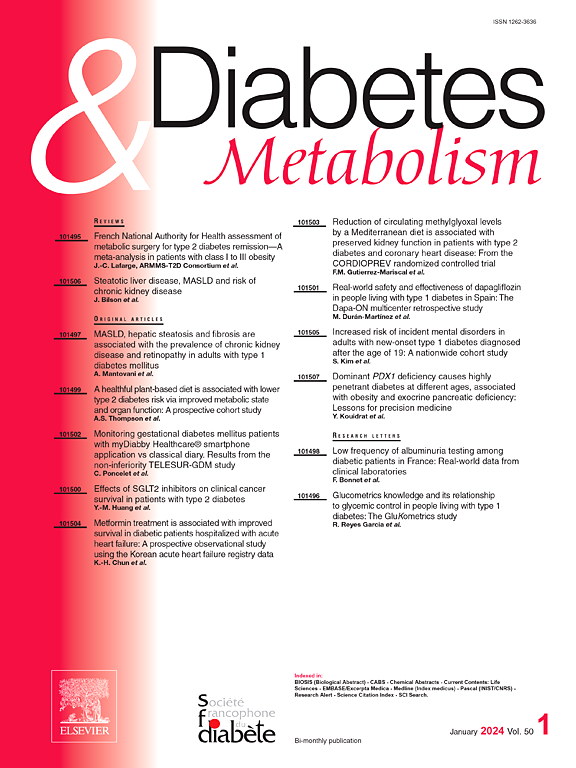Reduced risks of colorectal cancer with GLP-1RAs in type 2 diabetes: A nationwide cohort study using a target trial emulation framework
IF 4.7
2区 医学
Q1 ENDOCRINOLOGY & METABOLISM
引用次数: 0
Abstract
Aim
- Type 2 diabetes (T2D) is associated with increased risk of colorectal cancer (CRC). Glucagon-like peptide-1 receptor agonists (GLP-1RAs) may reduce CRC risk compared to insulin therapy; however, current evidence is controversial. We aimed to evaluate the association between CRC and the use of GLP-1RAs and long-acting insulins (LAIs).
Methods
- This target trial emulation employed nationwide data from a Taiwanese T2D cohort. We identified new GLP-1RA and LAI users from 2013 to 2021, and applied propensity score (PS) matching to ensure comparable baseline characteristics. The primary outcome was CRC. Follow-up lasted until outcome occurrence, death, or study end in 2022, whichever came first. Hazard ratios (HRs) with 95 % confidence intervals (CIs) were calculated to assess the association between treatment and outcomes. Sensitivity analyses—including stabilized inverse probability weighting, time-dependent survival analysis, E-values, and negative control outcome analyses—were conducted to test the robustness of findings.
Results
- We included 11,726 PS-matched pairs of GLP-1RA and LAI users and found no significant baseline disparities between cohorts. Compared to LAIs, GLP-1RAs were associated with significantly reduced CRC risk (HR [95 % CI]: 0.66 [0.48–0.92]), with the association limited to the rectum (HR: 0.53 [0.28–0.92]) but not observed in the right- or left-sided colon (right, HR: 0.69 [0.41–1.19]; left, HR: 0.77 [0.44–1.33]). These findings were consistent across sensitivity analyses and among patients with varying baseline characteristics.
Conclusion
- Among patients with T2D requiring injectable glucose-lowering agents, GLP-1RA use, compared to LAIs, was associated with reduced CRC risk, particularly in the rectum.
GLP-1RAs降低2型糖尿病患者患结直肠癌的风险:一项使用目标试验模拟框架的全国性队列研究
目的- 2型糖尿病(T2D)与结直肠癌(CRC)风险增加相关。与胰岛素治疗相比,胰高血糖素样肽-1受体激动剂(GLP-1RAs)可能降低结直肠癌的风险;然而,目前的证据是有争议的。我们的目的是评估结直肠癌与GLP-1RAs和长效胰岛素(LAIs)使用之间的关系。方法:这项目标试验模拟采用了台湾t2dm队列的全国数据。我们从2013年到2021年确定了新的GLP-1RA和LAI用户,并应用倾向评分(PS)匹配来确保可比较的基线特征。主要结局为结直肠癌。随访持续到2022年结果发生、死亡或研究结束,以先到者为准。计算95%置信区间(ci)的风险比(hr),以评估治疗与结果之间的关联。进行敏感性分析,包括稳定的逆概率加权、时间相关的生存分析、e值和阴性对照结果分析,以检验结果的稳健性。结果:我们纳入了11,726对ps匹配的GLP-1RA和LAI使用者,发现队列之间没有显著的基线差异。与LAIs相比,GLP-1RAs与显著降低结直肠癌风险相关(HR [95% CI]: 0.66[0.48-0.92]),这种关联仅限于直肠(HR: 0.53[0.28-0.92]),但在左右结肠(HR: 0.69 [0.41-1.19];左,HR: 0.77[0.44-1.33])。这些发现在敏感性分析和不同基线特征的患者中是一致的。结论:在需要注射降糖药的T2D患者中,与LAIs相比,GLP-1RA的使用与降低结直肠癌风险相关,特别是在直肠。
本文章由计算机程序翻译,如有差异,请以英文原文为准。
求助全文
约1分钟内获得全文
求助全文
来源期刊

Diabetes & metabolism
医学-内分泌学与代谢
CiteScore
12.00
自引率
4.20%
发文量
86
审稿时长
13 days
期刊介绍:
A high quality scientific journal with an international readership
Official publication of the SFD, Diabetes & Metabolism, publishes high-quality papers by leading teams, forming a close link between hospital and research units. Diabetes & Metabolism is published in English language and is indexed in all major databases with its impact factor constantly progressing.
Diabetes & Metabolism contains original articles, short reports and comprehensive reviews.
 求助内容:
求助内容: 应助结果提醒方式:
应助结果提醒方式:


